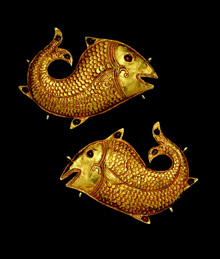Events
March 29, 2010
The art of adornment



“When Gold Blossoms: Indian Jewelry from the Susan L. Beningson Collection,” now on view at the Carlos Museum, celebrates the beauty and technical craftsmanship of Indian jewelry with more than 150 pieces spanning hundreds of years.
Primarily from South India, the selection includes intricate rings, nose rings, anklets, earrings, necklaces, hair pendants, ivory combs and jeweled crowns — a dazzling array of objects of adornment that reveals complex communication functions as well as cultural, spiritual and social beliefs.
“We are privileged to bring these exquisite cultural treasures to Atlanta,” says Carlos Museum Director Bonnie Speed. “More than stunning works of art, these objects speak to a rich and vibrant cultural heritage.”
Traditionally, jewelry in India has been worn and valued for both its ornamental and symbolic qualities. Replete with meaning, jewelry can reveal the wearer’s regional origins, beliefs, marital status, wealth and social position.
“When Gold Blossoms” not only celebrates the beauty and craftsmanship of Indian jewelry, but also examines how it was and continues to be worn to create and communicate identity in social and religious contexts.
“While the exhibit visually displays the jewelry as art, it’s important to remember that many of the pieces are or have been used in everyday adornment, adornment that reflects the identity of and gives auspiciousness to its wearer,” notes Joyce Flueckiger, professor of religion and site curator.
Flueckiger, who grew up in the Indian Himalayas and studies Hindu and Muslim popular traditions, travels often to India. Her photographs appear in the exhibition, including one from a friend’s wedding in Hyderabad that complements the ornaments of bridal ritual adornment on display. Another is a photograph of a village woman wearing heavy gold earrings, showing that gold is often worn by women who aren’t particularly wealthy, sometimes at great financial risk to the families.
As site curator, Flueckiger helped guide the exhibit’s design — notice the architecture of the “Temple Jewelry” section, patterned after a temple entry directed at the deity; and the golden, earth-toned backdrops. “As an anthropologist,” she explains, “I wanted to give an indication of how gold looks as it is worn in context of everyday life and hope that the colors suggest this.”
A rich series of related educational events and lectures will support a greater understanding of the religious and social aspects of Indian jewelry — from the sacredness of adorning the body to poetic imagery describing the adornment of deities of the Hindu pantheon, notes Flueckiger, who will speak about the gold wedding pendant’s significance in everyday life at an April 27 lecture.
She encourages the Emory community to visit the exhibit, on view until July 11.
“I hope that seeing this beautiful exhibit of ornamentation and learning more about jewelry in Indian contexts will cause viewers to notice and think about ornamentation in their own families and cultures in a new way,” Flueckiger says. “They may find that, explicitly or unexplicitly, the creative potential of adornment in their own contexts resonates with some of what they see in ‘When Gold Blossoms.’”
Organized by the Asia Society-New York, support for the exhibition in Atlanta was made possible by the E. Rhodes and Leona B. Carpenter Foundation, Emory’s Strategic Initiative in Religion, Society, and the Arts, and India-Atlanta Community Partners.
Admission is free for Emory faculty, staff and students and Carlos Museum members.
Video from 'When Gold Blossoms' opening program:
Quick Links
File Options
Related Information
Educational programs surrounding the exhibition range from an outdoor film festival to children’s art workshops to faculty lectures and performances.
